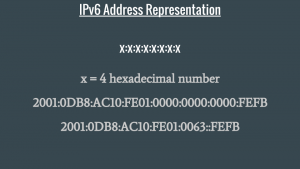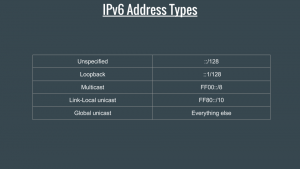Article Details
Completion Time: 20 min
Difficulty: Intermediate
Subject: Computer Network Technologies and services
This article is about IPv6 Addressing. We will first learn how to represent an IPv6 Address and then we will see the IPv6 Address Types.
1. IPv6 Address Representation
IPv6 Address is a 128 bit number. We can divide this number in 8 part of 16 bit. Each part of this number can be seen as 4 hexadecimal numbers. We separate these 8 parts by a colon. We have another rule for Address Representation. When we have a sequence of hexadecimal zeros in an address, we can replace all those zero with ::
2. IPv6 Address Types
Before speaking about address types, Let’s speak about address categories. we have 3 categories of IPv6 address: Anycast, Unicast and Multicast. Now Let’s talk about address types. To identify an IPv6 address we need to pay attention to its high-order bits (prefix).
Unspecified IPv6 Address
The address 0:0:0:0:0:0:0:0 is the unspecified address. It must never be assigned to any node. It indicates the absence of an address. One example of its use is in the Source Address field of any IPv6 packets sent by an initializing host before it has learned its own address.
Loopback IPv6 Address
The unicast address 0:0:0:0:0:0:0:1 is the loopback address. It may be used by a node to send an IPv6 packet to itself.
Multicast IPv6 Address
Multicast Addresses are used to send an IPv6 packet to a group of nodes. We have pre-defined well-known multicast addresses and the custom ones.
Link-Local unicast IPv6 Address
A Link-Local unicast Address is used to send a packet on the same link. It is used for purposes such as automatic address configuration, neighbor discovery.
Global unicast IPv6 Address
The global routing prefix identifies a site. The subnet ID is an identifier of a link within the site. The interface ID is an identifier of interfaces on a link. They are required to be unique within a subnet prefix. For all unicast addresses, (except those that start with the binary value 000) Interface IDs are required to be 64 bits long and to be constructed in Modified EUI-64 format.
3. Links and Literature
4. Thank you
Support my challenge, support my blog. Please Share this article if you found it useful. Thank you.




